The Surface 3 Review
by Brett Howse on May 4, 2015 9:00 AM ESTDisplay
When Surface Pro 3 moved to a 3:2 aspect ratio, it made a lot of sense. 16:9 in a tablet makes for a very poor experience, and in a laptop, it is not much better. Almost everyone has moved to 16:9 in the laptop space and the lack of vertical height can make for a less than ideal experience. Most web content is vertical, and working in Office means you want vertical space as well. The widescreen does help with two windows snapped open at once, but I always find myself craving more vertical room.
On a tablet, I feel that 16:9 is even worse. Holding a 16:9 device in one hand can feel very heavy due to the length of the tablet, and turning it to portrait means that it is very tall and skinny. The move to 3:2 really squares up the device, and makes it a lot more balanced in either direction. Holding it in one hand is much easier, and finally portrait mode is usable on the Surface.
So the aspect ratio is a big improvement. The display size also has a slightly wider corner to corner of 10.8 inches versus 10.6 inch model that came before this. The actual width of the display is about 9 inches, compared to 9.2 on the outgoing Surface 2 model. The display height is now 6 inches, up from 5.2, so the total area of the display is almost 54 square inches, up from 48 inches on the outgoing model.
To fill this display, we have a Panasonic panel with a resolution of 1920x1280. This is roughly the same pixel density as the Surface Pro 3’s slightly larger 12 inch 2160x1440 display, coming in at 217 pixels per inch. It is not the highest PPI of a tablet, but it makes a good compromise between desktop and tablet use. Speaking of desktop use, I found that it makes a perfectly acceptable size for a small notebook, and even with touch it was not too difficult to work with the icons.
When Microsoft launched Surface 3, it said “with incredibly accurate colors and clarity from multiple viewing angles” and that would be excellent to see. The Surface Pro 3 has a decent display, but it was not the most accurate device we’ve tested.
To do our display testing, we use SpectraCal’s CalMAN 5 suite with a custom workflow. Brightness and contrast readings are taken with an X-Rite i1Display Pro colorimeter, and color accuracy is measured with an X-Rite i1Pro spectrophotometer. We target 200 nits brightness when doing our tests.
Brightness and Contrast
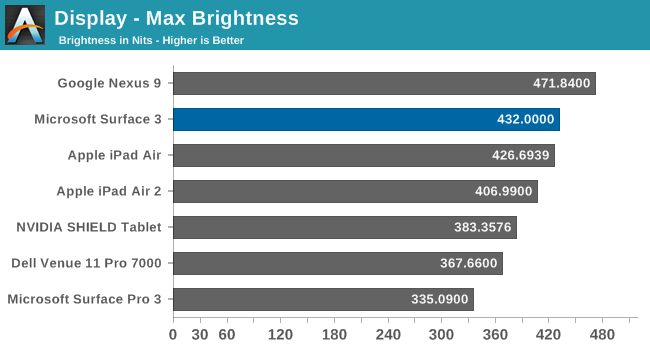
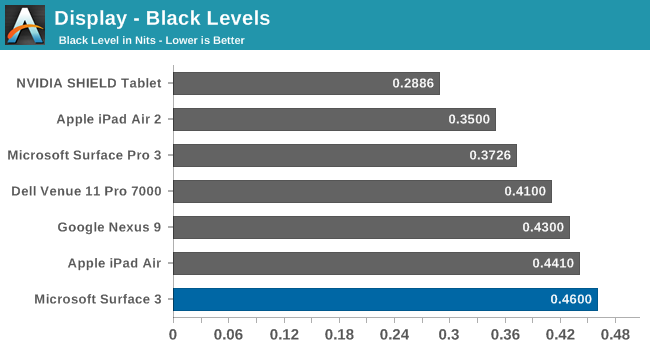
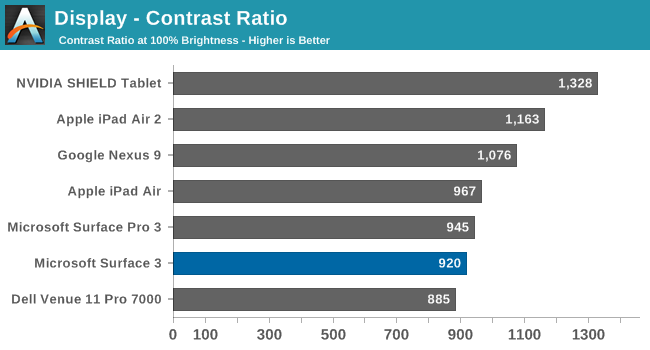
The Surface 3 gets quite bright, coming in at 432 nits at maximum output. The black levels are a bit high, but overall contrast is a decent 920:1. This makes the Surface 3 almost 100 nits higher than the Surface Pro 3 that Anand reviewed last year, which is a good start for this less expensive version.
Grayscale
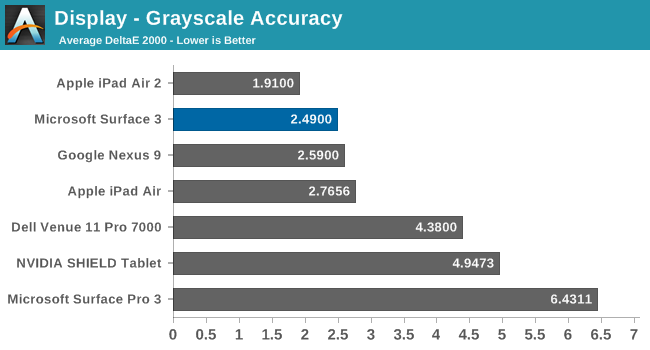
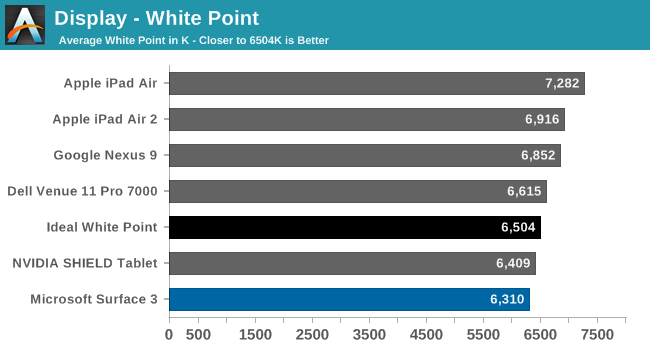
The grayscale average for the Surface 3 is very good, coming in just about at 2.5 as an average for the sweep. There is a bit of a spike at 25% but it is not indicative of the overall calibration. Gamma is a bit low, but the white point is fairly close to the ideal value.
Saturation
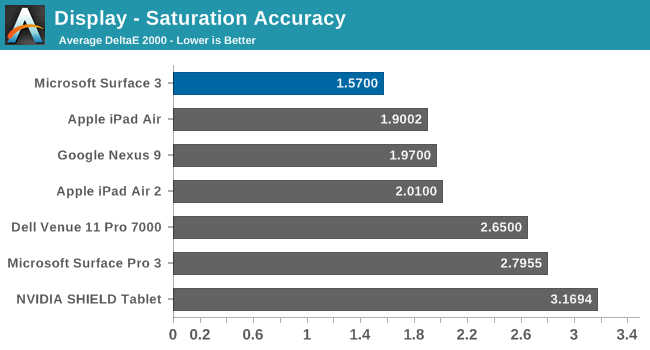
The accuracy on our saturation tests is outstanding, with an overall average score of just 1.57. Looking at the individual colors, the red is a bit oversaturated at 100%, and blue tends to be undersaturated, but the amount of error is very small.
Gamut and Gretag Macbeth
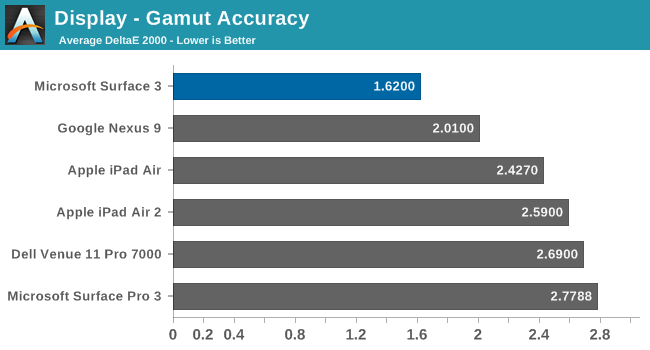
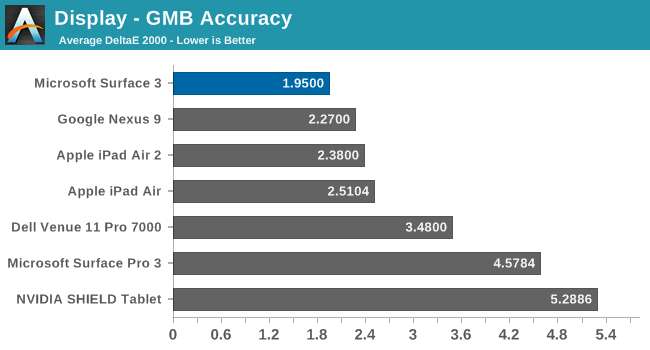
Once again the Surface 3 comes in with fantastic scores on these two tests, with the comprehensive GMB test under 2. When we are doing these tests, values under 3 are considered good, and the Surface 3 has passed with amazing scores. The best part of this is that all of this is done without the use of an ICC profile, so that means the hardware is being calibrated directly. ICC profiles can fix some issues, but not all programs respect them so having it done in hardware is a much better option.
Calibrated
Since this is a full x86 Windows operating system, we can also calibrate the display with the CalMAN software. Even though it was very good out of the box, the calibration pulls it even closer to perfection.
Surface 3 has one of the most accurate displays we have ever tested, which is great to see in what is considered the value member of the Surface family. Microsoft promised an accurate display and they have delivered.


















265 Comments
View All Comments
Luc K - Thursday, May 7, 2015 - link
Battery life of both Yoga 3 Pro and the Asus T300 Chi are not anywhere close to this one.Then again completely different kind of devices.
This Atom CherryTrail CPU is actually newer than Core M but different kind of line of CPU's obviously.
MattVincent - Tuesday, May 5, 2015 - link
The 64gb doesn't bother me but the 2gb of ram seems like its just cutting corners. Price goes up way to fast once you add on the accessories. They shouldn't be charging for the pen.TEAMSWITCHER - Tuesday, May 5, 2015 - link
Ya think? I just checked MacMall.com, and I can get a 2015 11" MacBook Air for $819. That includes an Intel Core i5 CPU with HD6000 graphics, a decent keyboard, industry leading trackpad, PCIe SSD, Thunderbolt port, 2 USB 3.0 ports, and MagSafe Power. The display on the Surface might be a little better, but the atom CPU and archaic storage are very more worse.I own an 2013 11" MacBook Air and have found it to be a very capable machine. The screen is small, but workable thanks to OS X's excellent full-screen app / virtual desktop implementation. When I'm in my office, I connect it to my 27" monitor, Apple Keyboard, & Magic Mouse and use it like any other desktop.
The Surface 3 possesses only one redeeming quality - a Pen. How bad are you willing to let Microsoft screw you over for a Pen? If the answer is "brutally" then buy a Surface 3.
xthetenth - Tuesday, May 5, 2015 - link
The screen isn't just small, it's wildly archaic with a low res and bad panel technology. I'd also love to see you try to use the air as a tablet. If you don't need a tablet, don't get a tablet, get an ultrabook.RafaelHerschel - Tuesday, May 5, 2015 - link
I considered a MacBook Air, but the screen was unacceptable at the price point. I'm sure that will be rectified in the future, but for now there are inexpensive Windows alternatives with much better screens.AnyOny24 - Wednesday, May 6, 2015 - link
If you want to talk about that price point you should talk about the Pro 3 core i5 which supports tablet mode / touch, the same pen you're talking about, bigger / better screen... silly comparison.damianrobertjones - Wednesday, May 6, 2015 - link
Or I can just buy the S3 along with a £20 BT keyboard.BlueBomberTurbo - Thursday, May 7, 2015 - link
Actually, the screen on the Surface 3 is the best portable screen you can get next to maybe the new Macbook. The Air's screen was terrible for anything requiring any level of color accuracy. You know, the artsy stuff that you can apparently only do on a Mac.The other redeeming qualities are its size and weight. I know I bought it specifically for those and the screen, as a portable workstation for my photography. When you cram lots of lenses and a couple camera bodies in your backpack, you're already hauling around a good amount of weight. A well-spec'd laptop certainly isn't going along for the ride, too.
lokhor - Tuesday, May 5, 2015 - link
Worst thing about the dock on the SP3 is that the angle cannot be adjusted so its virtually useless if you want to have it set up as a secondary screendigiguy - Tuesday, May 5, 2015 - link
Laughing out loud at the "bulky and heavy" comment. This tablet weights less than the ipad 4 and I was not hearing people call that bulky and heavy.... Better, this tablet has a whole inch more screen surface that the ipad.... But this is partly the fault of reviewers that call this a 10 inches device, like the ipad.... Why the ipad, that is 9.7 inches, is 10 inches and this one, at 10.8, is not 11 inches? Increase the screen size of the air and the weight will also go up, while still being a bit lighter, not to mention ipad 4 and below.I have a 600g 10.1 inches windows tablet and it feels very light and pleasant to hold with one hand, just awkward with its 16:9 ratio. The surface will feel more balanced.
Concerning storage speed, the 128GB model offers better performance (see this accurate review for more details http://www.notebookcheck.net/Microsoft-Surface-3-T...
Having said that, this is the performance with the encrypted SSD. Personally I decrypted the SDDs in all my tablets (Surface pro 3, HP Stream 8, etc.) and the performance, especially the sequential one, has significantly increased.